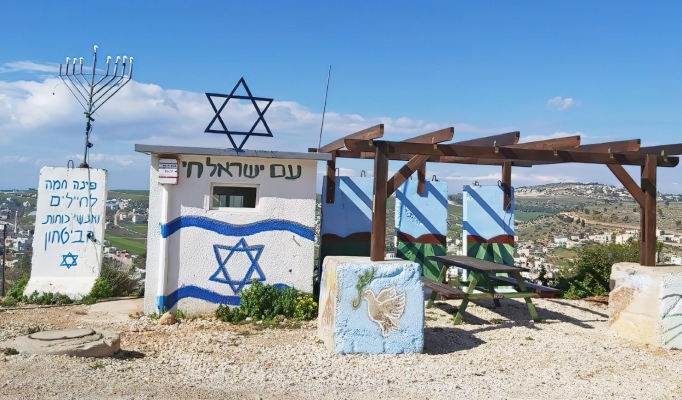Kibbutz Merav, Gilboa Mountain Range
Text and Photos by Lydia Aisenberg
The heavy mid-morn mist spreads a chilly dampness around the religious community of Merav, which was settled in 1982 atop Mt. Avinadav in the Gilboa mountain range. Gradually the mist lifts and, the accompanying slight drizzle peters out.
Bright, warm sunshine slowly breaks through pockets of puffy white clouds against a bluer by the minute sky, spreading its welcome embrace over the kibbutz, Mt. Avinadav, and the surrounding cluster of the wide, round peaked hills of the Gilboa range.The rays of sunshine also envelop the expansive valley floor below, and within minutes, as if a screen had been lifted, deep green pastures, crop filled and recently ploughed fields stretch as far as one can see. On the gentle lower slopes surrounding the valley, whitewashed stone houses gleam as they bask in the sunshine.
The all-embracing silence and serenity surrounding my vantage point high above is suddenly broken by the sound from below of a softly braying donkey, who is seemingly answered by high velocity barking dogs, followed by a sudden burst of excited and gleeful shouts of young children as they spill out of classes for morning break.
The villages below are Palestinian (post-Oslo designated Palestinian Authority Area A). They are situated on the other side of the security fence and patrol road that snakes its way across the Gilboa Mountain range where the extensive range begins to peter out. The road drops down toward the Jordan Valley and the Israeli town of Beit Shean on one side, and into the eastern portion of the Jezreel Valley on the other. Palestinian villages stretch all the way to the Palestinian city of Jenin.
To the right of the vantage point and in the near distance, perched on yet another rounded hill, sits Kibbutz Maale Gilboa. Running along the ridge between the two hilltop kibbutzim, standing out like spinning windmills across the horizon, are a number of gigantic wind turbines that comprise the Maale Gilboa Wind Farm.
The security fence and accompanying white chalky patrol road wend their way along the slope. One of the Palestinian villages spreads out from the valley floor upward toward the fence. From the Merav vantage point, the distance between the homes of the more veteran religious kibbutz of Maale Gilboa and those of their Palestinian neighbors are very close.
Actually, very close indeed.
Spring flowers can already be seen in red and blue clusters poking up from the rich greenery on both sides of the security fence. The pastoral beauty, absolute quietness (apart from the aforementioned interruptions) and deep appreciation of Mother Nature are somewhat shattered when I begin to read a lengthy inscription on a large white rock to the side of the viewing veranda.
It was here that in 2001 a teenage resident of Kibbutz Merav was brutally murdered by armed Palestinian terrorists who had set out from Jenin with murder on their minds. The terrorists laid in wait, hugging the hill under the Merav approach road, hidden by a copse of trees. When a car passed by carrying four schoolgirls from the kibbutz, they opened fire, killing 17 year-old Aliza Malka and wounding the other three girls. The driver was uninjured.
Aliza hailed from Bat Yam but had been living at Merav for three years, as part of a program to give a welcoming home to youth from disadvantaged backgrounds, or distressed youth who had been abused and removed from their families by local authorities.The kibbutz has also opened a center for women with special needs, and a home for lone soldiers serving in the IDF, Beit Michael, named after Staff Sergeant Michael Levin, an American-Israeli paratrooper who was killed in action in 2006 during the Second Lebanon War.
The heart-breaking text on the memorial stone attests to how the community deeply felt the loss of Aliza, whom the Merav community described collectively at the end of the inscription as "our girl." The lookout platform, built some years later, is well tended, with pathways, benches and a herbal garden overlooking the Palestinian villages below on the other side of the security fence.
Just meters away from the Aliza Malka memorial vantage point, on the lip of the approach road, sits a square white concrete guard post, half of which is decorated with a large painted Israeli flag with the words Am Israel in large Hebrew letters above. On the roof, an enormous metal Magen David stands out boldly against the blue sky and obviously can be seen by the Palestinians for miles on the other side of the security fence.
Another large concrete block stands alongside the guard post, with an enormous metal menorah, bearing the wording: "Warm greetings to all soldiers and security personnel."
On the other side of the guard tower, a much smaller concrete block depicts, on a pale blue backdrop, a white dove holding a very large olive branch in its beak.
From just a few meters away, on the left hand side of the guardpost, one can see the Palestinian villages on the lower slopes and the red roofs of Kibbutz Maale Gilboa sitting atop the hill, with rolls of barbed wire and the IDF patrol road and fence running between them.
The dove with the large olive branch, unlike the Magen David and Menorah, can only be seen on the Israeli side.
Please Note:
Since the writing of this article, both Kibbutz Merav and Maale Gilboa have sustained sporadic firing from Palestinian terrorists.









Comments